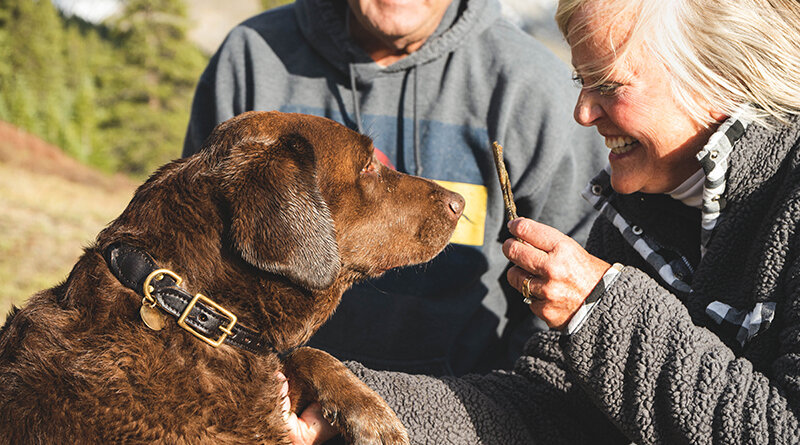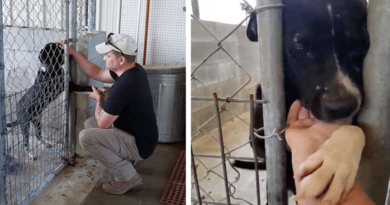Train Your Dog, Train the People in Your Life: Part 3
The skill set of ideas, techniques and strategies used by positive-reinforcement dog trainers is widely applicable to other situations and can easily be used to influence the behavior of many other species (including humans). In her new book, Treat Everyone Like a Dog, Karen B. London, PhD, delves into the ways these skills can be deployed to make life easier for everyone—dogs and people alike.
Part 3 of our discussion with Karen London on her new book. Here, she considers why people find the idea of using positive-reinforcement techniques with their personal relationships so intriguing, and how those techniques play out in her own family life.
Bark: In her 2006 essay in the New York Times, “What Shamu Taught Me About a Happy Marriage,” Amy Sutherland considered a similar synergy between positive reinforcement and relationships. It reportedly was one of the NYT’s most emailed columns ever up to that point. Clearly, this is a topic that resonates with people. Any ideas why?
Karen London: It’s been a lot of fun for me since my book came out to learn how many other dog trainers (and trainers of other animals as well) see how easily our skills at work translate to situations in our personal lives. In the last month or so, since the release of Treat Everyone Like a Dog, I have heard so many wonderful stories about how other dog trainers treat their clients like they want those clients to treat their dogs, or how they taught their kids a recall for safety or how they reinforce their spouses when those spouses do something they want them to do again.
GET THE BARK IN YOUR INBOX!
Sign up for our newsletter and stay in the know.
I think the idea of using positive dog-training techniques, skills and ideas to influence the behavior of our fellow humans resonates with people for many reasons. It’s easy for people to see that dog trainers are able to teach dogs an amazing array of skills, and that the dogs are happy about the entire process. People see that dogs have been taught to turn away from squirrels, to stay on their dog bed throughout a dinner party and to let go of whatever’s in their mouth, and that they do these things cheerfully and consistently. So, many folks understand that it’s worth learning how such skills are taught.
People also see the joy of the learning process in the field of dog training and how the “best friend” label between dogs and people truly applies, and they want a piece of that. Dog training enhances relationships, and those improved relationships enhance the training process. Who wouldn’t want those same things—happy learning experiences, effective teaching and better relationships—when it comes to the people in their lives?
Positive dog training allows us to be our very best with dogs—no guilt, no nagging, no harshness. Likewise, who wouldn’t want to be able to teach others and influence their behavior without resorting to negativity? In the context of dog training, I often say that force is the absence of real power. What that means is if you can ask a dog to do something with a quiet request, there is no need to push or yell or use any other unpleasant means to get what you want. I believe that if people are able to get others to act as they want them to without yelling, whining, threatening or being negative in any way, they will choose that option. It’s so much more pleasant, and makes everyone involved happier.
In dog training, we’re always looking for a better way, continuously improving based on scientific research, new ideas and our own experiences. Those outside of the field also want a better way to interact. In my experience, people are interested in kinder, gentler, more loving ways to teach and train. When ideas about how to do better are presented, most people drink them in enthusiastically.
Over the years, I have had many clients who have previously worked with old-fashioned coercion trainers. When they come to me, they are elated and relieved to learn that they can train dogs humanely and positively, without fear or pain. Many of them were uncomfortable being harsh with their dog, and that’s why they sought other options. Without knowing the specifics of how to train their dogs more kindly, they were unsure what to do, but they knew what they were looking for as soon as they found it.
I think the same thing is true for people and their interactions with other people: They know what they’re looking for as soon as they find it. Treating people gently and with positivity when teaching them—as the best and most skilled dog trainers treat their dogs—appeals to so many people because it’s what they want to do, whether they knew it or not.
Though a major theme of Treat Everyone Like a Dog is the use of positive reinforcement, how to use it effectively, and lots of stories and examples of doing so, there is more to my book than just this one technique. In addition to positive reinforcement, I discuss the use of classical conditioning, the importance of ethology for understanding those we seek to teach, the specific skills taught to dogs that also make sense for people to learn, learning strategies and styles, lots of tricks of the trade for changing behavior, and the ways I observe the world and those in it from a dog trainer’s perspective.
B: Finally (because we can’t resist asking), do your sons or husband put these principles to use with others—and perhaps with you?
KL: Absolutely they do! I see it all the time, but when I asked them for examples, it was hard for them to come up with any because it’s all so natural to them. For my family, being positive and teaching in effective ways is just life as usual, and I’m not always convinced they associate it with dog training specifically.
I do see that the rest of my family will ignore behavior they don’t like in young children who are trying to get their attention but will engage with those same children when they make appropriate social overtures. They effusively praise kids for looking both ways before crossing the street or for not running into the street even when their toy has rolled into the road. They all have a tendency to “catch people doing something right” and react positively to such behaviors, whether in children or adults.
One thing I notice with my husband (a professor) is that when he’s working with students who are preparing manuscripts for publication, he will concentrate on one aspect of the process at a time, using each draft as an opportunity to focus primarily on content, organization, statistical analysis or some other element, lowering his criteria in areas that are not the focus. For dog trainers, this is common, with the classic example being the three main components of a solid stay: the distance you move away from the dog during the stay, the duration of the stay and the level of distraction during the stay. If any one component is hard for a dog, we make the others easier for success and for the best progress in learning. So, for example, if distractions are high, we keep it short and stay close to the dog so she can succeed and improve.
Additionally, my husband sets up his students for success when they face the difficult and stressful experience of presenting talks at national meetings. (Setting dogs up for success is a fundamental tenet of successful dog training.) He does that in a lot of ways: having them practice a lot and making sure their talk is within the time limit, their slides are high quality and their organization tells the story of the research effectively. He prepares them for the experience by having them attend conferences to observe how the process works so they aren’t going into a completely unknown situation. Finally, he encourages them to ask a question during the Q & A section of a talk given before their own; that way, they will have already spoken out loud in that setting and begin to feel comfortable having their voice heard in that context.
My sons are generous in their social media likes, and I’ve often thought that this is a way of offering positive reinforcement and not feeling a need to be stingy about it. Also, I think my sons and I (along with my husband) are in a wonderful positive-reinforcement loop related to being out and doing things. As long as the kids let me know where they are and when they’ll be home, I’m comfortable with them being out. They reinforce our “yes, you can; sure, go ahead” behavior with information and notifications about changes of plans/locations/times, and we reinforce their keeping us in the loop by saying yes to their requests to do fun things and go fun places. (This has been far less frequent during Covid-19, since we all have fewer activities out of the house, but it still applies.)
The way Brian and Evan say “thank you” with genuine appreciation when I do little things for them—for example, baking a favorite item, bringing their tea to them in the morning or filling their water bottles as they prepare to head out for a hike or a bike ride—is also a form of positive reinforcement. True, everyone should say “thank you” and show basic manners, but not everyone does. Also, some people say “thank you” often but not with sincerity. The fact is, I find it reinforcing when they thank me in way that shows genuine appreciation, and that means, by definition, that it is reinforcing.
I also think that as a family, we see that people may not be behaving in a desirable way because of some barrier to success. None of us are quick to blame people for acting in a way we don’t like, and we are all quick to recognize when people are struggling and need help to be at their best.





cheap erectile dysfunction: ed drugs list new ed pills
comprare farmaci online all’estero https://kamagrait.club/ acquistare farmaci senza ricetta
Metabo Flex is a nutritional formula that enhances metabolic flexibility by awakening the calorie-burning switch in the body. The supplement is designed to target the underlying causes of stubborn weight gain utilizing a special “miracle plant” from Cambodia that can melt fat 24/7. https://metaboflexbuynow.us/
tor markets links tor dark web darknet links
Your posts are always so well-written and thought out It’s evident that you put a lot of effort into each and every one
Sumatra Slim Belly Tonic takes pride in its manufacturing process, ensuring that every batch is produced in FDA-approved and GMP-certified facilities. This means that each and every bottle of Sumatra Slim Belly Tonic meets the highest standards of quality and safety. You can trust that you are getting a product that has undergone strict quality control measures and is backed by scientific research.
Sugar Defender orchestrates a reduction in blood sugar levels through multifaceted pathways. Its initial impact revolves around enhancing insulin sensitivity, optimizing the body’s efficient use of insulin, ultimately leading to a decrease in blood sugar levels. This proactive strategy works to prevent the storage of glucose as fat, mitigating the risk of developing type 2 diabetes.
Your blog has been a constant source of support and encouragement for me I am grateful for your words of wisdom and positivity